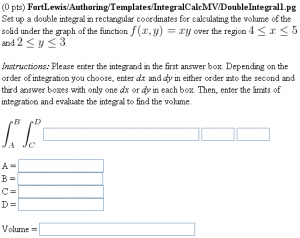DoubleIntegral1
This problem has been replaced with a newer version of this problem
Setting up a Double Integral
This PG code shows how to allow students to set up a double integral and integrate in either order.
- PGML location in OPL: FortLewis/Authoring/Templates/IntegralCalcMV/DoubleIntegral1_PGML.pg
| PG problem file | Explanation |
|---|---|
|
Problem tagging: |
|
DOCUMENT(); loadMacros( "PGstandard.pl", "MathObjects.pl", "parserMultiAnswer.pl", ); TEXT(beginproblem()); |
Initialization:
Since there are multiple answer blanks that are dependent upon each other, we use |
Context('Numeric');
Context()->variables->are(
x => 'Real',
dx => 'Real',
y => 'Real',
dy => 'Real'
);
Context()->flags->set(reduceConstants => 0);
#
# limits of integration
#
$a = random(1, 5, 1);
$b = $a + random(1, 4, 1);
do { $c = random(1, 5, 1); } until ($c != $a);
do { $d = $c + random(1, 4, 1); } until ($d != $b);
#
# integrand and volume
#
$f = Formula('x*y');
$V = Formula("($b^2-$a^2) * ($d^2-$c^2) / 4");
#
# differentials and limits of integration
#
# Case 0, element 0 of each array below, is
# if the order of integration is dx dy
#
# Case 1, element 1 of each array below, is
# if the order of integration is dy dx
#
# 'id' and 'od' stand for inner and outer differential
#
@id = (Formula('dx'), Formula('dy')); # (case 0, case 1)
@od = (Formula('dy'), Formula('dx')); # (case 0, case 1)
#
# A = outer integral, lower limit
# B = outer integral, upper limit
# C = inner integral, lower limit
# D = inner integral, upper limit
#
@A = (Formula("$c"), Formula("$a")); # (case 0, case 1)
@B = (Formula("$d"), Formula("$b")); # (case 0, case 1)
@C = (Formula("$a"), Formula("$c")); # (case 0, case 1)
@D = (Formula("$b"), Formula("$d")); # (case 0, case 1)
$multians = MultiAnswer($f, $id[0], $od[0], $A[0], $B[0], $C[0], $D[0])->with(
singleResult => 1,
checker => sub {
my ($correct, $student, $self) = @_;
my ($fstu, $idstu, $odstu, $Astu, $Bstu, $Cstu, $Dstu) = @{$student};
if (
(
$f == $fstu
&& $id[0] == $idstu
&& $od[0] == $odstu
&& $A[0] == $Astu
&& $B[0] == $Bstu
&& $C[0] == $Cstu
&& $D[0] == $Dstu
)
|| ($f == $fstu
&& $id[1] == $idstu
&& $od[1] == $odstu
&& $A[1] == $Astu
&& $B[1] == $Bstu
&& $C[1] == $Cstu
&& $D[1] == $Dstu)
)
{
return 1;
} elsif (
(
$f == $fstu
&& $id[0] == $idstu
&& $od[0] == $odstu
&& ($A[0] != $Astu || $B[0] != $Bstu)
&& $C[0] == $Cstu
&& $D[0] == $Dstu
)
|| ($f == $fstu
&& $id[1] == $idstu
&& $od[1] == $odstu
&& ($A[1] != $Astu || $B[1] != $Bstu)
&& $C[1] == $Cstu
&& $D[1] == $Dstu)
|| ($f == $fstu
&& $id[0] == $idstu
&& $od[0] == $odstu
&& $A[0] == $Astu
&& $B[0] == $Bstu
&& ($C[0] != $Cstu || $D[0] != $Dstu))
|| ($f == $fstu
&& $id[1] == $idstu
&& $od[1] == $odstu
&& $A[1] == $Astu
&& $B[1] == $Bstu
&& ($C[1] != $Cstu || $D[1] != $Dstu))
)
{
$self->setMessage(1, 'Check your limits of integration.');
return 0.94;
} elsif (
(
$f == $fstu
&& $id[0] == $idstu
&& $od[0] == $odstu
&& ($A[0] != $Astu || $B[0] != $Bstu)
&& ($C[0] != $Cstu || $D[0] != $Dstu)
)
|| ($f == $fstu
&& $id[1] == $idstu
&& $od[1] == $odstu
&& ($A[1] != $Astu || $B[1] != $Bstu)
&& ($C[1] != $Cstu || $D[1] != $Dstu))
)
{
$self->setMessage(1, 'Check your limits of integration and order of integration.');
return 0.47;
} else {
return 0;
}
}
);
|
Setup:
There are two separate cases: integrating with respect to
The |
BEGIN_PGML
Set up a double integral in rectangular coordinates
for calculating the volume of the solid under the
graph of the function [` f(x,y) = [$f] `] over the
region [` [$a] \leq x \leq [$b] `] and [` [$c] \leq y \leq [$d] `].
_Instructions:_
Please enter the integrand in the first answer box.
Depending on the order of integration you choose,
enter _dx_ and _dy_
in either order into the second and third answer boxes
with only one _dx_ or _dy_ in each box.
Then, enter the limits of
integration and evaluate the integral to find the volume.
[`` \int_A^B \int_C^D ``]
[___________]{$multians} [_____]{$multians} [_____]{$multians}
A = [_____________]{$multians}
B = [_____________]{$multians}
C = [_____________]{$multians}
D = [_____________]{$multians}
Volume = [___________________________]{$V}
|
Main Text:
The only interesting thing to note here is that you must use |
BEGIN_PGML_SOLUTION
Solution explanation goes here.
END_PGML_SOLUTION
COMMENT('Allows integration in either order. Uses PGML.');
ENDDOCUMENT();
|
Solution: |
